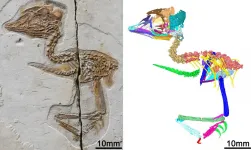Addressing inequity in air quality
2021-06-23
(Press-News.org) Air quality varies greatly within regions and cities around the world, and exposure to air pollution can have severe health impacts. In the U.S., people of color are disproportionately exposed to poor air quality. A cover story in Chemical & Engineering News, the weekly newsmagazine of the American Chemical Society, highlights how scientists and community activists are using new technologies to gather data that could help address this inequity.
Despite the success of the U.S. Clean Air Act in improving ambient air quality over the past 50 years, discriminatory housing, loan and other policies -- known as redlining -- have limited where people of color can live. That means they are more likely to live near "pollution hot spots," such as warehouses, freeways and ports, writes Senior Correspondent Katherine Bourzac. As a result, communities of color have a higher risk of developing cardiovascular disease, asthma and other health issues. Although regulatory air monitors are being operated by federal and local agencies, they typically can't capture air-quality differences within cities.
To fill the gaps, researchers are combining air-pollution measurement technologies with land-use data, modeling studies and other data collection methods. For example, scientists studying air quality in Houston using satellites and U.S. Census Bureau data determined that majority Black, Hispanic and Latino neighborhoods had 37% higher levels of nitrogen dioxide than majority white communities. Scientists hope that higher resolution data from satellites and ground-based tools will help policymakers mitigate inequity and adverse health effects due to air pollution.
INFORMATION:
The article, "A local look at air pollution highlights inequalities within cities," is freely available here.
The American Chemical Society (ACS) is a nonprofit organization chartered by the U.S. Congress. ACS' mission is to advance the broader chemistry enterprise and its practitioners for the benefit of Earth and all its people. The Society is a global leader in promoting excellence in science education and providing access to chemistry-related information and research through its multiple research solutions, peer-reviewed journals, scientific conferences, eBooks and weekly news periodical Chemical & Engineering News. ACS journals are among the most cited, most trusted and most read within the scientific literature; however, ACS itself does not conduct chemical research. As a leader in scientific information solutions, its CAS division partners with global innovators to accelerate breakthroughs by curating, connecting and analyzing the world's scientific knowledge. ACS' main offices are in Washington, D.C., and Columbus, Ohio.
To automatically receive news releases from the American Chemical Society, contact newsroom@acs.org.
Follow us: Twitter | Facebook
ELSE PRESS RELEASES FROM THIS DATE:
2021-06-23
Over recent years, the retina has established its position as one of the most promising biomarkers for the early diagnosis of Alzheimer's. Moving on from the debate as to the retina becoming thinner or thicker, researchers from the Universidad Complutense de Madrid and Hospital Clínico San Carlos are focusing their attention on the roughness of the ten retinal layers.
The study, published in Scientific Reports, "proves innovative" in three aspects according to José Manuel Ramírez, Director of the IIORC (Ramón Castroviejo Institute of Ophthalmologic Research) at the UCM. "This is the first study to propose studying the roughness of the retina and its ten constituent layers. They have devised a mathematical method to measure the degree of wrinkling, through the fractal ...
2021-06-23
Children with obstructive sleep apnea are nearly three times more likely to develop high blood pressure when they become teenagers than children who never experience sleep apnea, according to a new study funded by the National Heart, Lung, and Blood Institute (NHLBI), part of the National Institutes of Health. However, children whose sleep apnea improves as they grow into adolescence do not show an increased chance of having high blood pressure, which is a major risk factor for heart disease.
The long-term study, one of the largest of its kind in the pediatric population, underscores the seriousness of sleep apnea in children and the importance of early treatment, the researchers said. Their findings appear online in the journal JAMA Cardiology.
Obstructive sleep apnea, ...
2021-06-23
Previous research was falsely reassuring; captured only 2% of cirrhosis patients
Findings underscore lack of access to health care for Black patients
Cirrhosis is leading cause of death and affects more than 600,000 people in U.S.
CHICAGO --- Black patients with cirrhosis - late-stage liver disease - are about 25% more likely to die compared to non-Hispanic white patients and four times less likely to receive a liver transplant, reports a new Northwestern Medicine study.
Estimates of racial disparity in cirrhosis have been limited by a lack of large-scale longitudinal data, which track patients from diagnosis to death and/or transplant.
The paper is one of the first to link all seven large liver centers in Chicago with the death registry and transplant registry to examine ...
2021-06-23
Psycholinguists from the HSE Center for Language and Brain, in collaboration with researchers from the City University of New York and the University of Stuttgart, investigated how reading in Russian varies among different groups of readers. The authors used a novel method in bilingualism research -comparison of the eye-movement sequences (scanpaths) in adult native speakers of Russian, Russian-speaking children, and adult bilinguals with different levels of Russian proficiency. The results of the study were published in Reading Research Quarterly.
A total of 120 readers took part in the study, with 30 participants in each group. Participants included adult ...
2021-06-23
BUFFALO, N.Y. -- The giant plumose anemone is an animal, but it looks a bit like an underwater cauliflower. Its body consists of a stalk-like column that attaches to rocks and other surfaces on one end, and to a crown of tentacles on the other.
The anemones use these feelers to collect and shove food into their mouths, and a new study provides an in-depth look into the rich diversity of prey the anemones are catching. This includes a surprising menu item: ants, specifically the pale-legged field ant, Lasius pallitarsis. And the occasional spider.
The research was published on June 15 in the journal Environmental DNA. The study focused on giant plumose ...
2021-06-23
How long do virus-laden particles persist in an elevator after a person infected with COVID-19 leaves? And is there a way to detect those particles? A group of electrical engineers and computer scientists at KAUST set out to answer these questions using mathematical fluid dynamics equations.
"We found1 that virus-laden particles can still be detected several minutes after a short elevator trip by an infected person," says KAUST electrical engineer Osama Amin.
The team's equations and breath simulations suggest that a biosensor's ability to detect a virus improves when placed on an elevator wall that can reflect particles. Also, to protect future occupants, the amount of particles in the air can be reduced by making the other three walls absorptive.
Amin ...
2021-06-23
COLUMBIA, Mo. - Throughout her 20-year career as a nurse practitioner, Jennifer Hulett noticed survivors of breast cancer would often express gratitude for being alive and mention God or a divine acknowledgement that had improved their health and well-being.
Now an assistant professor at the University of Missouri Sinclair School of Nursing, Hulett is researching the benefits of spirituality on improving immune health and reducing stress, as well as the chances of cancer reoccurrence, among breast cancer survivors.
In a recent study, Hulett collected and froze samples of saliva from 41 breast cancer survivors at MU's Ellis Fischel Cancer Center. ...
2021-06-23
Researchers from the Institute of Vertebrate Paleontology and Paleoanthropology (IVPP) of the Chinese Academy of Sciences have discovered a 120-million-year-old partial fossil skeleton of a tiny extinct bird that fits in the palm of the hand and preserves a unique skull with a mix of dinosaurian and bird features.
The two-centimeter-long (0.75 inch) skull of the fossil shares many structural and functional features with the gigantic Tyrannosaurus rex, indicating that early birds kept many features of their dinosaurian ancestors and their skulls functioned much like those of dinosaurs rather than living ...
2021-06-23
MINNEAPOLIS/ST. PAUL (06/23/2021) -- A new report from the University of Minnesota Medical School's Healthy Youth Development - Prevention Research Center (HYD-PRC) highlights that Minnesota youth continue to contract sexually transmitted infections (STIs) at alarmingly high rates, despite the COVID-19 pandemic.
The 2021 Minnesota Adolescent Sexual Health Report says that chlamydia and gonorrhea rates among Minnesota adolescents in 2020 are likely underreported, as both STI testing and case detection were scaled back during the early stages of the pandemic. However, teen pregnancy rates remain virtually unchanged from 2018, and birth rates are at historic lows for ...
2021-06-23
The stink of ammonia in urine, sweat, and rotting meat repels humans, but many insects find ammonia alluring. Now, UConn researchers have figured out how the annoying insects smell it, a discovery that could lead to better ways to make them buzz off.
The sense of smell is enormously important. Mammals devote a third of their genetic code to odor receptors found in the nose, and have more than 1,000 different kinds that allow us to smell an estimated trillion different odors.
Flies don't have noses. Instead, they smell with their antenna. Each antenna is covered with tiny hairs called sensilla. Each sensilla contains a few neurons--fly brain cells. Each neuron expresses one type of odor receptor, and they all fall into two main ...
LAST 30 PRESS RELEASES:
[Press-News.org] Addressing inequity in air quality




